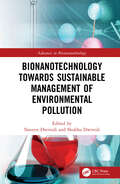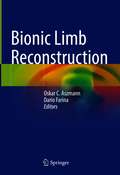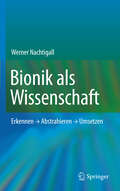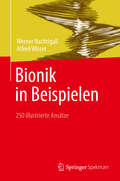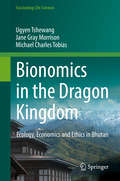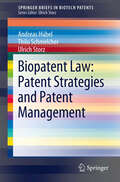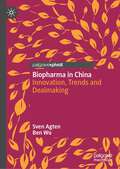- Table View
- List View
Bionanotechnology for Advanced Applications (Advances in Bionanotechnology)
by Ajaya Kumar Singh Bhawana JainThis book provides the fundamental aspects of bionanomaterials and bionanotechnology, and insight into the synthesis and modification of bionanomaterials in a detailed manner. It initiates with a general overview of biotechnology and nanotechnology followed by different strategies and methodologies for the synthesis of nanomaterials. Further, it discusses pertinent topics such as protein engineering, analysis, mechanisms of microbe- mediated nanosynthesis, followed by various challenges and innovation strategies, and the role of enzymes in bionanotechnology.Features: Covers the synthesis of bionanomaterials, including the interaction between nanomaterial and biogenic materials Encompasses the study of the connections between structure, molecular biology, and nanotechnology Explains several techniques (XRD, SEM, TEM, etc.) used for the analysis of bionanomaterials Includes prospects, challenges, and opportunities associated with bionanotechnology Reviews the interaction between nanomaterials and the biological system and self- assembly in bionanotechnology This book is aimed at graduate students and researchers in materials sciences, biotechnology, and bionanotechnology.
Bionanotechnology for Advanced Applications (Advances in Bionanotechnology)
This book provides the fundamental aspects of bionanomaterials and bionanotechnology, and insight into the synthesis and modification of bionanomaterials in a detailed manner. It initiates with a general overview of biotechnology and nanotechnology followed by different strategies and methodologies for the synthesis of nanomaterials. Further, it discusses pertinent topics such as protein engineering, analysis, mechanisms of microbe- mediated nanosynthesis, followed by various challenges and innovation strategies, and the role of enzymes in bionanotechnology.Features: Covers the synthesis of bionanomaterials, including the interaction between nanomaterial and biogenic materials Encompasses the study of the connections between structure, molecular biology, and nanotechnology Explains several techniques (XRD, SEM, TEM, etc.) used for the analysis of bionanomaterials Includes prospects, challenges, and opportunities associated with bionanotechnology Reviews the interaction between nanomaterials and the biological system and self- assembly in bionanotechnology This book is aimed at graduate students and researchers in materials sciences, biotechnology, and bionanotechnology.
Bionanotechnology II: Global Prospects
by David E. ReisnerThe impact and importance of nanotechnology continues to grow, and nanomedicine and biotechnology have become areas of increased development. Biomedical engineers who work with biological processes and structures must have a deeply rooted understanding of the role of bionanotechnology, a rapidly evolving sector of the nanotechnology field. Bionanot
Bionanotechnology in Cancer: Diagnosis and Therapy
by D. Sakthi Kumar Aswathy Ravindran GirijaThe cancer research world is looking forward to bionanotechnology to find the best solutions for a complete cure from cancer, which is not possible with the current established treatment methods. The past decade of research on nano imaging and drug delivery in cancer has witnessed many interesting papers and reviews, but there has not been a concise resource that discusses all fields related to nano cancer research in diagnosis and drug delivery. This book fills this gap and presents the latest bionano research in cancer, focusing on nanodiagnostics and nanotherapy. The book is organized into two sections. The section on nanodiagnostics focuses on topics such as diagnostic methods in cancer-related therapy and use of radiolabeled nanoparticles, magnetic nanoparticles, acoustically reflective nanoparticles, X-ray computed tomography, and optical nanoprobes for diagnosis. The section on nanotherapy focuses on nanomaterials in chemotherapy, magnetic nanoparticles for hyperthermia against cancer, phototherapy, nanotechnology-mediated radiation therapy, nanoparticle-mediated small-RNA deliveries for molecular therapies, and theranostics. The book will serve as the gateway to enter the beautiful and elegant field of bionanoscience, which is considered the last hope for the fight against cancer and will be a highly useful resource for the students, researchers, teachers, and curious readers working in this field or related fields.
Bionanotechnology in Cancer: Diagnosis and Therapy
by D. Sakthi Kumar Aswathy Ravindran GirijaThe cancer research world is looking forward to bionanotechnology to find the best solutions for a complete cure from cancer, which is not possible with the current established treatment methods. The past decade of research on nano imaging and drug delivery in cancer has witnessed many interesting papers and reviews, but there has not been a concise resource that discusses all fields related to nano cancer research in diagnosis and drug delivery. This book fills this gap and presents the latest bionano research in cancer, focusing on nanodiagnostics and nanotherapy. The book is organized into two sections. The section on nanodiagnostics focuses on topics such as diagnostic methods in cancer-related therapy and use of radiolabeled nanoparticles, magnetic nanoparticles, acoustically reflective nanoparticles, X-ray computed tomography, and optical nanoprobes for diagnosis. The section on nanotherapy focuses on nanomaterials in chemotherapy, magnetic nanoparticles for hyperthermia against cancer, phototherapy, nanotechnology-mediated radiation therapy, nanoparticle-mediated small-RNA deliveries for molecular therapies, and theranostics. The book will serve as the gateway to enter the beautiful and elegant field of bionanoscience, which is considered the last hope for the fight against cancer and will be a highly useful resource for the students, researchers, teachers, and curious readers working in this field or related fields.
Bionanotechnology Towards Sustainable Management of Environmental Pollution (Advances in Bionanotechnology)
by Naveen Dwivedi Shubha DwivediThis book highlights the characteristics, aims, and applications of bionanotechnology as a possible solution for sustainable management and bioremediation of environmental pollutants. It covers remediation of toxic pollutants, removal of emerging contaminants from industrial wastewater, eco-design and modification study of bio-nanoparticles and life-cycle assessment, nano-filtration, bio-nanomaterials based sensors for monitoring air and water pollution, resource recovery from wastewater, and highlights Internet of things-based green nanotechnology.Provides a comprehensive solution of environmental problems in sustainable and cost-effective modeReviews bionanotechnological applications in nanomaterials design, modification, and treatment of emerging contaminants from industrial wastewater.Covers Eco-design study of bio-nanomaterials, bio-nano filters, and assessment for the treatment of emerging pollutantsIncludes IoT- based bionanotechnologyExplores future research needs on bionanotechnology and scientific challenges in the mitigation of environmental pollutantsThis book is aimed at researchers, professionals, and graduate students in nanobiotechnology, environmental engineering, biotechnology.
Bionanotechnology Towards Sustainable Management of Environmental Pollution (Advances in Bionanotechnology)
by Naveen Dwivedi Shubha DwivediThis book highlights the characteristics, aims, and applications of bionanotechnology as a possible solution for sustainable management and bioremediation of environmental pollutants. It covers remediation of toxic pollutants, removal of emerging contaminants from industrial wastewater, eco-design and modification study of bio-nanoparticles and life-cycle assessment, nano-filtration, bio-nanomaterials based sensors for monitoring air and water pollution, resource recovery from wastewater, and highlights Internet of things-based green nanotechnology.Provides a comprehensive solution of environmental problems in sustainable and cost-effective modeReviews bionanotechnological applications in nanomaterials design, modification, and treatment of emerging contaminants from industrial wastewater.Covers Eco-design study of bio-nanomaterials, bio-nano filters, and assessment for the treatment of emerging pollutantsIncludes IoT- based bionanotechnologyExplores future research needs on bionanotechnology and scientific challenges in the mitigation of environmental pollutantsThis book is aimed at researchers, professionals, and graduate students in nanobiotechnology, environmental engineering, biotechnology.
Bionic Limb Reconstruction
by Oskar C. Aszmann Dario FarinaThis book presents the latest techniques in amputation rehabilitation and summarizes the most recent research findings in the field of bionic limb reconstruction. Divided into seven parts written by experts in the field, it provides valuable information on e.g. upper extremity injuries, psychological considerations, prosthetic engineering, and surgical and rehabilitation strategies. Illustrative figures and photos of real-life settings further assist understanding. This book is of interest not only for plastic surgeons, but also for hand surgeons, orthopedic and trauma surgeons as well as therapists, prosthetists and engineers.
Bionik: Grundlagen und Beispiele für Ingenieure und Naturwissenschaftler
by Werner NachtigallDieses umfassende Lehrbuch wendet sich an Studenten, Fachleute und Wissenschaftler und liegt somit im Niveau deutlich über den üblichen Sachbüchern zur Bionik. Es wird gezeigt, was Bionik ist, wie sie sich entwickelt hat, wie man Fragen stellt und was Bionik leisten kann. Im Detail diskutiert das Buch ausgewählte Beispiele aus den verschiedensten technologischen Bereichen. Es bietet auch einen Zugang zum wissenschaftlichen und gesellschaftlichen Umfeld der Bionik. Die vielfältigen Facetten dieser interdisziplinären Wissenschaft fügen sich in diesem anspruchsvollen Werk puzzleartig zu einer "Biostrategie in die Zukunft" zusammen. Seit dem Erscheinen der 1. Auflage hat sich die Bionik vielseitig weiterentwickelt. Das Buch wurde daher von Grund auf neu geschrieben, wobei einige bewährte Abschnitte beibehalten wurden. Der Umfang wurde verdoppelt, die Zahl der Beispiele vervierfacht.
Bionik: Bionisches Konstruieren verstehen und anwenden
by Welf WawersDieses Lehrbuch erklärt anschaulich Anwendung aus der Bionik an zahlreichen Beispielen und vermittelt eine Vorgehensweise für die Identifizierung biologischer Lösungen und deren Übertragung auf technische Anwendungen. Basisinformationen der Biologie und Grundlagen der Konstruktionstechnik gewährleisten einen leichten Zugang zum Stoff. Mit dem 3D-Druck als Schlüsseltechnologie und der Thematisierung der Nachhaltigkeit geht das Buch zudem auf aktuelle Entwicklungen ein. Dieser ganzheitliche Blick soll den Leser zur Durchführung bionischer Projekte befähigen und motivieren.
Bionik als Wissenschaft: Erkennen - Abstrahieren - Umsetzen
by Werner NachtigallDer Begriff „BIONIK“ wird gerne als Kunstwort gekennzeichnet, zusammengesetzt aus BIOlogie und TechNIK. Bionik stellt einerseits ein Fach dar, in dem geforscht und ausgebildet wird, und kennzeichnet andererseits eine Sichtweise, nämlich die des „Lernens von der Natur für die Technik“. Darüber sind in der Zwischenzeit neben populär wissenschaftlichen Werken eine Reihe von Fachbüchern erschienen. Werner Nachtigall hat darin mit der 2. Auflage seines bei Springer erschienenen Buchs „BIONIK – Grundlagen und Beispiele für Ingenieure und Naturwissenschaftler“ einen Meilenstein gesetzt. In diesem Buch kennzeichnet er die Untergliederung des Fachs und bespricht detailliert dessen Forschungsgegenstände. Dagegen fehlte bislang eine Darstellung, die sich mit den erkenntnistheoretischen Grundlagen wie mit der pragmatischen Vorgehensweise der Bionik systematisch befasst, die ja mit der ihr eigenen Prinzip-Abstraktion zwischen der belebten Welt als Vor-Bild und der technischen Umsetzung als Ab-Bild vermitteln will. Das vorliegende Werk schließt diese Lücke mit drei großen Abschnitten: Biologische Basis: Erforschen, Beschreiben, Beurteilen. – Abstraktion biologischer Befunde: Herausarbeiten allgemeiner Prinzipien. – Umsetzung in die Technik: Prinzipvergleich, Konzeptuelles, Vorgehensweise.
Bionik in Beispielen: 250 illustrierte Ansätze
by Werner Nachtigall Alfred WisserBionik betreiben bedeutet, von der Natur für die Technik lernen. Die Wissenschaft „Bionik“ lässt sich in mehrere Teilgebiete untergliedern, von Materialien und Strukturen über Verfahren und Abläufe bis zu Evolution und Optimierung. Auf all diesen Gebieten gibt es bereits vielerlei Ansätze. In der Öffentlichkeit - und seltsamerweise auch in den naturwissenschaftlichen Fachdisziplinen - sind aber nur wenige wirklich bekannt. Dazu zählen der Lotus-Effekt, umgesetzt für die Verschmutzungsverminderung von Fassaden, und der Haischuppen-Effekt, umgesetzt für die Widerstandsreduzierung von Flugzeugen. Dabei gibt es aber heute schon hunderte von hochinteressanten Ansätzen, die eine Umsetzung von Naturprinzipien in die Technik zum Inhalt haben. Aus der Fülle dieser Ansätze sind für das vorliegende Buch 250 ausgewählt nach „Vorgeschichte“, „Frühgeschichte“, „Klassik“ und „Neuzeit“. Die meisten Beispiele sind neuerer Art. Jedes Beispiel umfasst in gleichartiger Gliederung eine Druckseite. Die Beispiele aus dem Bereich „Neuzeit“ sind in Blocks gegliedert, die den Unterdisziplinen der Bionik entsprechen.
Bionomics in the Dragon Kingdom: Ecology, Economics and Ethics in Bhutan (Fascinating Life Sciences)
by Ugyen Tshewang Jane Gray Morrison Michael Charles TobiasThis compact and elegant work (equally fitting for both academic as well as the trade audiences) provides a readily accessible and highly readable overview of Bhutan’s unique opportunities and challenges; all her prominent environmental legislation, regulatory statutes, ecological customs and practices, both in historic and contemporary terms. At the same time, Bionomics places the ecological context, including a section on animal rights in Bhutan, within the nation’s Buddhist spiritual and ethical setting. Historic contextualization accents the book’s rich accounting of every national park and scientific reserve, as well as providing up-to-the-minute climate-change related hurdles for the country.Merging the interdisciplinary sciences, engineering and humanities data in a compelling up-to-date portrait of the country, the authors have presented this dramatic compendium against the backdrop of an urgent, global ecological time-frame. It thus becomes clear that the articulated stakes for Bhutan, like her neighboring Himalayan and Indian sub-continental countries (China, India, Bangladesh and Myanmar) are immense, as the Anthropocene epoch unfolds, affecting every living being across the planet. Because Bhutan’s two most rewarding revenue streams derive from the sale of hydro-electric power and from tourism, the complexities of modern pressures facing a nation that prides herself on maintaining traditional customs in what has been a uniquely isolated nation are acute.
Bioorganic Chemistry: A Chemical Approach to Enzyme Action (Springer Advanced Texts in Chemistry)
by Hermann DugasSpringer Advanced Texts In Chemistry New textbooks at all levels of chemistry appear with great regularity. Some fields like basic biochemistry, organic reaction mechanisms, and chemical thermody namics are well represented by many excellent texts, and new or revised editions are published sufficiently often to keep up with progress in research. However, some areas of chemistry, especially many of those taught at the graduate level, suffer from a real lack of up-to-date textbooks. The most serious needs occur in fields that are rapidly changing. Textbooks in these subjects usually have to be written by scientists actually involved in the research that is advancing the field. It is not often easy to persuade such individuals to set time aside to help spread the knowledge they have accumulated. Our goal, in this series, is to pinpoint areas of chemistry where recent progress has outpaced what is covered in any available textbooks, and then seek out and persuade experts in these fields to produce relatively concise but instructive introductions to their fields. These should serve the needs of one semester or one quarter graduate courses in chemistry and biochemistry. In some cases the availability of texts in active research areas should help stimulate the creation of new courses.
Bioorganic Marine Chemistry (Bioorganic Marine Chemistry #1)
by John W. Blunt William Fenical Nobuhiro Fusetani Peter Karuso Richard T. Luibrand Murray H.G. Munro Valerie J. PaulThe present series, "Bio-organic Marine Chemistry," is being launched at a time when we have the fundamental knowledge and the requisite instrumentation to probe the molecular basis of many biological phenomena. The final volume of "Marine Natural Products-Chemical and Biological Perspectives" (Academic Press), which may be con sidered the precursor of this series, was published in 1983. In that series, which I edited, primary emphasis was placed on molecular structure and phyletic relationships. This focus was compatible with the major concerns of a growing research community in the field of marine natural products. Moreover, a need existed for timely reviews of a rapidly expanding and widely scattered primary literature. As I read again the Preface to Volume 1 (1978), I am amazed at the changes in direction and emphasis which have taken place during these few intervening years. Sufficient basic data are now at hand to gauge the breadth of the marine natural product spectrum and to raise questions of functions, both within and outside the marine ecosystem. Although we have few answers, the questions have become meaningful and pointed. Furthermore, the task of tracking and cataloguing the steady stream of fascinating new structures has been assumed by Faulkner's periodic surveys in Natural Product Reports, a bimonthly publication of the Royal Society of Chemistry. The study of marine natural products remains firmly anchored in chemistry, i. e. in molecular integrity, yet continues to seek greater involvement in functional biology.
Bioorganic Marine Chemistry (Bioorganic Marine Chemistry #2)
by J. C. Coll G. B. Elyakov R. J. Quinn P. W. Sammarco V. A. Stonik K. TachibanaBurgeoning research into marine natural products during the past two decades has in no small measure been due to an heightened and world-wide interest in the ocean, to the development of new sophisticated computer-driven instrumentation, and to major advances in separation science. Organic chemists have been fully aware that processes in living systems occur in an aqueous medium. Nevertheless, the chemists who have specialized in the study of small molecules have found it expedient to use organic rather than aqueous solvents for the isolation and manipulation of secondary metabolites. The emergence of new chromatographic techniques, the promise of rewarding results, not to mention the relevance of polar molecules to life itself, have contributed to a new awareness of the importance of organic chemistry in an aqueous medium. The first chapter in Volume 2 of Bioorganic Marine Chemistry reflects the growing interest and concern with water-soluble com pounds. Quinn, who pioneered the separation of such molecules, has contributed a review which closely links techniques with results and is based on practical experience. The second chapter, by Stonik and Elyakov, examines the vast chemical literature of the phylum Echinodermata - over one fourth of it in difficulty accessible Russian language publications. The Soviet authors evaluate the data for their suitability as chemotaxonomic markers.
Bioorganic Marine Chemistry (Bioorganic Marine Chemistry #3)
by A. R. Davis M. P. Foster C. M. Ireland J. Kobayashi M. Kobayashi O. J. McConnell T. C. McKee T. F. Molinski D. J. Newman Y. Ohizumi D. M. Roll K. Sakata K. Snader M. Suffness N. Suzuki J. C. Swersey N. M. Targett C. M. Young T. M. ZabriskieThe first three chapters of Vol. 3 of Bio-organic Marine Chemistry deal with the chemistry and function of peptides. Chapter 1 by Ireland and coworkers serves as an introduction to marine-derived peptides. It is arranged phyletically and encompasses the entire range from dipeptides to a compound with 95 amino acid residues. Peptides involved in primary metabolism and hence belonging to the realm of macromolecular biochemistry are excluded. However, it might be mentioned in passing that the dividing line between large and small molecule chemistry is continually becoming less distinct. Not only are more compounds of intermediate size, from 1,000 to 10,000 dalton, being discovered, but instruments and techniques, particularly in mass spectrometry and nuclear magnetic resonance have been developed for their structural elucidation by what is considered small molecule methodology. Two groups of peptides are discussed in separate chapters. Biologists who have observed and described the mating behavior of diverse species of marine invertebrates have long surmised that a chemical mechanism might be operating in many cases of individual as well as mass fertilization. The chemical activators of sea urchin sperm prove to be a series of peptides, whose structures and activity are discussed by Suzuki.
Biopacemaking (Series in Biomedical Engineering)
by J. A. E Spaan Ruben Coronel Jacques M. T. De Bakker Antonio ZazaThe development of a bio-engineered pacemaker is of substantial clinical and also scientific interest because it promises to overcome several limitations of electronic pacemakers. Moreover it may answer the longstanding question of whether the complex structure of the sinus node is indeed a prerequisite for reliable pacemaking, or simpler structures might work as well. This book gives an overview of the current state-of-the-art of creating a bio-engineered pacemaker. It shows the approaches to develop of genetic and cell-based engineering methods suitable to implement them with safety and stability. It also illuminates the problems that need to be solved before bio-pacemaking can be considered for clinical use.
Biopatent Law: Patent Strategies and Patent Management (SpringerBriefs in Biotech Patents)
by Andreas Hübel Thilo Schmelcher Ulrich StorzPatents protecting biotechnological invention are becoming ever more important. Because biotechnology has many differences with respect to other technologies, lessons learned in other fields of technology cannot simply be transferred to adopt a suitable strategy for dealing with biotechnology inventions. In this volume, general aspects of biopatent law will be discussed. This involves questions of patentability, including ethical issues and issues of technicality, as well as questions of patent exhaustion in cases were reproducible subject matter, like cells or seeds, is protected. Moreover, active and passive patent strategies are addressed. Further, insight will be given into patent lifetime management and additional protective measures, like supplementary protection certificates and data exclusivity. Here, strategies are discussed how market exclusivity can be extended as long as possible, which is particularly important for biopharmaceutical drugs, which create high R&D costs.
Biopharma in China: Innovation, Trends and Dealmaking
by Sven Agten Ben WuThis book provides an insider’s overview of the emerging Chinese biopharma sector, its dynamics and trends, first bust and boom cycle, long-term perspectives, and how as a foreign company or investor to tap into this. China has gone from a country with no innovation in drug discovery, to a country which starts to out-license its biopharma technology to the rest of the world. The Chinese biopharma sector is only a decade old, but it already has become a new driver of growth and value. The book takes a closer look at what drives Chinese innovation in the biopharma sector, how to deal with this innovation, and what opportunities and challenges this provides for foreign companies. The book also takes a deep dive into its first biopharma boom and bust cycle, and what it means for the sector. It also explains what deals Chinese biopharma companies and investors are looking for, what works and what doesn’t, and how as a foreign company can tap into the world’s second largest healthcare market.
Biopharmaceutical Applied Statistics Symposium: Volume 2 Biostatistical Analysis of Clinical Trials (ICSA Book Series in Statistics)
by Karl E. Peace Ding-Geng Chen Sandeep MenonThis BASS book Series publishes selected high-quality papers reflecting recent advances in the design and biostatistical analysis of biopharmaceutical experiments – particularly biopharmaceutical clinical trials. The papers were selected from invited presentations at the Biopharmaceutical Applied Statistics Symposium (BASS), which was founded by the first Editor in 1994 and has since become the premier international conference in biopharmaceutical statistics. The primary aims of the BASS are: 1) to raise funding to support graduate students in biostatistics programs, and 2) to provide an opportunity for professionals engaged in pharmaceutical drug research and development to share insights into solving the problems they encounter.The BASS book series is initially divided into three volumes addressing: 1) Design of Clinical Trials; 2) Biostatistical Analysis of Clinical Trials; and 3) Pharmaceutical Applications. This book is the second of the 3-volume book series. The topics covered include: Statistical Approaches to the Meta-analysis of Randomized Clinical Trials, Collaborative Targeted Maximum Likelihood Estimation to Assess Causal Effects in Observational Studies, Generalized Tests in Clinical Trials, Discrete Time-to-event and Score-based Methods with Application to Composite Endpoint for Assessing Evidence of Disease Activity-Free , Imputing Missing Data Using a Surrogate Biomarker: Analyzing the Incidence of Endometrial Hyperplasia, Selected Statistical Issues in Patient-reported Outcomes, Network Meta-analysis, Detecting Safety Signals Among Adverse Events in Clinical Trials, Applied Meta-analysis Using R, Treatment of Missing Data in Comparative Effectiveness Research, Causal Estimands: A Common Language for Missing Data, Bayesian Subgroup Analysis with Examples, Statistical Methods in Diagnostic Devices, A Question-Based Approach to the Analysis of Safety Data, Analysis of Two-stage Adaptive Seamless Trial Design, and Multiplicity Problems in Clinical Trials – A Regulatory Perspective.
Biopharmaceutical Applied Statistics Symposium: Volume 1 Design of Clinical Trials (ICSA Book Series in Statistics)
by Karl E. Peace Ding-Geng Chen Sandeep MenonThis BASS book Series publishes selected high-quality papers reflecting recent advances in the design and biostatistical analysis of biopharmaceutical experiments – particularly biopharmaceutical clinical trials. The papers were selected from invited presentations at the Biopharmaceutical Applied Statistics Symposium (BASS), which was founded by the first Editor in 1994 and has since become the premier international conference in biopharmaceutical statistics. The primary aims of the BASS are: 1) to raise funding to support graduate students in biostatistics programs, and 2) to provide an opportunity for professionals engaged in pharmaceutical drug research and development to share insights into solving the problems they encounter.The BASS book series is initially divided into three volumes addressing: 1) Design of Clinical Trials; 2) Biostatistical Analysis of Clinical Trials; and 3) Pharmaceutical Applications. This book is the first of the 3-volume book series. The topics covered include: A Statistical Approach to Clinical Trial Simulations, Comparison of Statistical Analysis Methods Using Modeling and Simulation for Optimal Protocol Design, Adaptive Trial Design in Clinical Research, Best Practices and Recommendations for Trial Simulations in the Context of Designing Adaptive Clinical Trials, Designing and Analyzing Recurrent Event Data Trials, Bayesian Methodologies for Response-Adaptive Allocation, Addressing High Placebo Response in Neuroscience Clinical Trials, Phase I Cancer Clinical Trial Design: Single and Combination Agents, Sample Size and Power for the Mixed Linear Model, Crossover Designs in Clinical Trials, Data Monitoring: Structure for Clinical Trials and Sequential Monitoring Procedures, Design and Data Analysis for Multiregional Clinical Trials – Theory and Practice, Adaptive Group-Sequential Multi-regional Outcome Studies in Vaccines, Development and Validation of Patient-reported Outcomes, Interim Analysis of Survival Trials: Group Sequential Analyses, and Conditional Power – A Non-proportional Hazards Perspective.
Biopharmaceutical Applied Statistics Symposium: Volume 3 Pharmaceutical Applications (ICSA Book Series in Statistics)
by Karl E. Peace Ding-Geng Chen Sandeep MenonThis BASS book Series publishes selected high-quality papers reflecting recent advances in the design and biostatistical analysis of biopharmaceutical experiments – particularly biopharmaceutical clinical trials. The papers were selected from invited presentations at the Biopharmaceutical Applied Statistics Symposium (BASS), which was founded by the first Editor in 1994 and has since become the premier international conference in biopharmaceutical statistics. The primary aims of the BASS are: 1) to raise funding to support graduate students in biostatistics programs, and 2) to provide an opportunity for professionals engaged in pharmaceutical drug research and development to share insights into solving the problems they encounter.The BASS book series is initially divided into three volumes addressing: 1) Design of Clinical Trials; 2) Biostatistical Analysis of Clinical Trials; and 3) Pharmaceutical Applications. This book is the third of the 3-volume book series. The topics covered include: Targeted Learning of Optimal Individualized Treatment Rules under Cost Constraints, Uses of Mixture Normal Distribution in Genomics and Otherwise, Personalized Medicine – Design Considerations, Adaptive Biomarker Subpopulation and Tumor Type Selection in Phase III Oncology Trials, High Dimensional Data in Genomics; Synergy or Additivity - The Importance of Defining the Primary Endpoint, Full Bayesian Adaptive Dose Finding Using Toxicity Probability Interval (TPI), Alpha-recycling for the Analyses of Primary and Secondary Endpoints of Clinical Trials, Expanded Interpretations of Results of Carcinogenicity Studies of Pharmaceuticals, Randomized Clinical Trials for Orphan Drug Development, Mediation Modeling in Randomized Trials with Non-normal Outcome Variables, Statistical Considerations in Using Images in Clinical Trials, Interesting Applications over 30 Years of Consulting, Uncovering Fraud, Misconduct and Other Data Quality Issues in Clinical Trials, Development and Evaluation of High Dimensional Prognostic Models, and Design and Analysis of Biosimilar Studies.
Biopharmaceutical Drug Design and Development
by Susanna Wu-Pong Yon RojanasakulThis book provides a comprehensive examination of the newest biopharmaceutical drugs. Among the drugs discussed are ones in the categories of monoclonal antibodies for in-vivo use, cytokines, growth factors, enzymes, immunomodulators, thrombolytics, and immonotherapies including vaccines. Additionally, the volume examines new and emerging technologies, and contains a review of the Human Genome Project.



